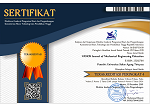FAILURE MODE AND EFFECT ANALYSIS (FMEA) AS TREATMENT OF PREDICTIVE PREVENTION AND LEAKAGE OF BOILER TYPE BALANCE DRAF FAN
Abstract
Risk analysis aims to prevent the incompatibility of a system used in the testing process including the Boiler system. At the Labuan 2 Steam Power Plant (PLTU) 2, the Boiler component was declared "very often" to have a pipe leak. Failure Mode And Effect Analysis (FMEA) is a method used to analyze the risk of failure. This method is represented by calculating the value of RPN (Risk Priority Number) obtained from the results of the multiplication of S (severty), O (occurrence), and D (detection). The highest analysis results are shown at 480 (in the steam drum component in the form of abnormal steam and water level failure). The cause is human error. Next three levels below are (1) Economizer component, which is 360 causes of combustion side ash erosion, material lifetime, and economizer tube fibration; (2) super heater tube and re-heater tube components which are 320 due to Corrosion, Overheat Flyash erosion, Sub blower erosion, Welding error; and (3) Walltube which is 320 causes of overheating and sub blower erosion. The recommendation for the analysis of FMEA testing to predict mantenance is done by applying remaining life assessment after 8,000 hours / operational.
Keywords
Full Text:
PDFReferences
Ahamed Mohideen, P. B. and Ramachandran, M. (2014) ‘Strategic approach to breakdown maintenance on construction plant - UAE perspective’, Benchmarking. doi: 10.1108/BIJ-05-2012-0030.
Ben-Daya, M. (2009) ‘Failure mode and effect analysis’, in Handbook of Maintenance Management and Engineering. doi: 10.1007/978-1-84882-472-0_4.
Braaksma, A. J. J., Klingenberg, W. and Veldman, J. (2013) ‘Failure mode and effect analysis in asset maintenance: A multiple case study in the process industry’, International Journal of Production Research. doi: 10.1080/00207543.2012.674648.
Chiarini, A. (2012) ‘Risk management and cost reduction of cancer drugs using Lean Six Sigma tools’, Leadership in Health Services. doi: 10.1108/17511871211268982.
Forman, E. and Selly, M. (2003) Decision by Objectives (How to convince others that you are right), Journal-Operational Research Society. doi: 10.1142/9789812810694.
Ilangkumaran, M. and Thamizhselvan, P. (2010) ‘Integrated hazard and operability study using fuzzy linguistics approach in petrochemical industry’, International Journal of Quality and Reliability Management. doi: 10.1108/02656711011043526.
Kaya, D. and Eyidogan, M. (2010) ‘Energy conservation opportunities in an industrial boiler system’, Journal of Energy Engineering. doi: 10.1061/(ASCE)0733-9402(2010)136:1(18).
Kolich, M. (2014) ‘Using Failure Mode and Effects Analysis to design a comfortable automotive driver seat’, Applied Ergonomics. doi: http://dx.doi.org/10.1016/j.apergo.2014.01.007.
Liao, C. J. and Ho, C. C. (2014) ‘Risk management for outsourcing biomedical waste disposal - Using the failure mode and effects analysis’, Waste Management. doi: 10.1016/j.wasman.2014.03.007.
López-Tarjuelo, J. et al. (2014) ‘Failure mode and effect analysis oriented to risk-reduction interventions in intraoperative electron radiation therapy: The specific impact of patient transportation, automation, and treatment planning availability’, Radiotherapy and Oncology. doi: 10.1016/j.radonc.2014.11.012.
Murphy, M., Heaney, G. and Perera, S. (2011) ‘A methodology for evaluating construction innovation constraints through project stakeholder competencies and FMEA’, Construction Innovation. doi: 10.1108/14714171111175891.
Robin E. McDermott, Raymond J. Mikulak and Michael R. Beauregard (2009) The Basics of FMEA, Taylor & Francis Group. doi: 10.1017/CBO9781107415324.004.
Segismundo, A. and Augusto Cauchick Miguel, P. (2008) ‘Failure mode and effects analysis (FMEA) in the context of risk management in new product development: A case study in an automotive company’, International Journal of Quality & Reliability Management. doi: 10.1108/02656710810908061.
SNI ISO/IEC 17025:2008 (2008) ‘Persyaratan umum kompetensi laboratorium pengujian dan laboratorium kalibrasi’, BSN. doi: 10.1371/journal.pone.0100326.
DOI: http://dx.doi.org/10.30870/vanos.v3i2.4558
Refbacks
- There are currently no refbacks.

This work is licensed under a Creative Commons Attribution 4.0 International License.


.png)
.png)
